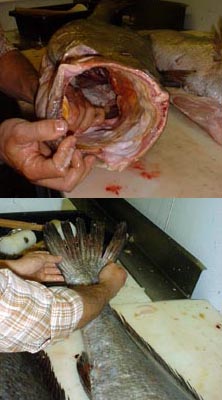|
The SDCC found two totoaba (Totoaba macdonaldi) for sale in Tucson, Arizona. These pictures are of two very large sciaenids (croakers) for sale on 4/2/01 at the 17th Street Farmers Market. They were for sale as "white sea bass" from the Gulf of California. Please take a close look at the pictures. Only three sciaenids from the Gulf of California attain such a size, Cynoscion nobolis (white sea bass), C. xanthulus (orange mouth corvina), and Totoaba macdonaldi (totoava). The pictures of the ventral side illustrate the lack of the prominent scale-ridge found in Cynoscion nobilis. The lateral line extends well onto the caudal fin along the middle rays, which are the longest, thereby creating a distinct angular shape. The pictures of the mouth show a slight yellow coloration, and illustrate very clearly the lack of two prominent canine teeth (found on the roof of the mouth of C. xanthulus), as well as the lack of a row of small teeth (found on the roof of the mouth of C. nobilis). The roof of the mouth is smooth , with rows of conical teeth along the mandible, maxillary, and premaxillary, as is found in Totoaba macdonaldi (Allen and Robertson 1998, Thomson and McKibbin 1976, Miller and Lea 1972).
|
||||||||||||||||||||
  |
||||||||||||||||||||
|
The totoaba is the largest croaker in the world, reaching a weight in excess of 135kg and a length of 2m, and once supported an important commercial fishery (Barragan and Tejeda 1988, Felger and Moser 1985).
|
||||||||||||||||||||
 |
||||||||||||||||||||
|
The totoaba, which is found exclusively in the northern Gulf of California, used the Colorado River delta as spawning and nursery grounds. With the Colorado River delta devastated due to the overexploitation of its waters by the United States, the fishery crashed and the totoaba is now the only marine fish listed under CITES and ESA as it faces extinction. Despite this protected status, one can easily buy totoaba in Tucson, Arizona. The SDCC proceeded to alert the US Fish and Wildlife department, which has obtained a specimen and is currently "investigating" the source of the fish in Mexico. To date we have noticed no reduction in the sale of this endangered species in Tucson. Please look for Totoaba in your area and inform us if you see them for sale. |
||||||||||||||||||||
|
||||||||||||||||||||
|
||||||||||||||||||||
